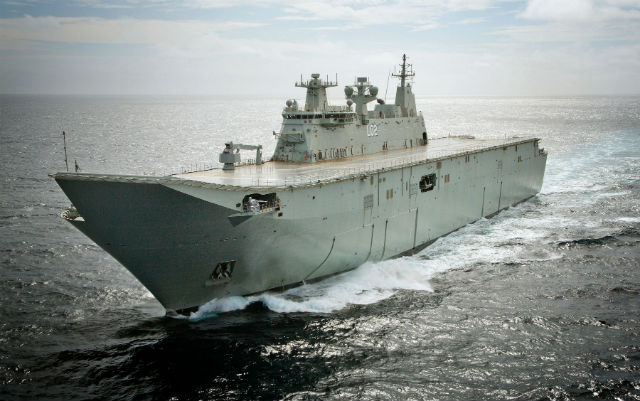The Royal Australian Navy commissioned its first of two Canberra-class landing helicopter dock (LHD) vessels at a ceremony in Sydney on 28 November.
HMAS Canberra and her sister ship – to be christened HMAS Adelaide late next year – will be the largest vessels ever operated by the navy. They are based on the Strategic Projection Ship design from Navantia, an example of which is in service with the Spanish navy as the King Juan Carlos I.

Commonwealth of Australia
Each LHD has a displacement of 27,500t at full load, and can accommodate 18 NH Industries MRH90 Taipan, Sikorsky MH-60R Seahawk or Airbus Helicopters Tiger armed reconnaissance helicopters, up to 110 armoured vehicles, four amphibious landing craft inside a well dock with sea door and a battalion of up to 1,200 troops. The 230m (757ft)-long design has a 1,390m2 (15,000ft2) hangar/light vehicle deck and a 1,860m2 heavy vehicle deck.The ship also has sufficient generating capacity to be able to export electricity into the power grid of a small city that may have been affected by a natural disaster.
The flightdeck has six landing spots for medium-sized helicopters, or four for the larger Boeing CH-47F Chinook – seven of which will be delivered to the Australian army from next year. Aircraft elevators are located forward and aft, while there is also a forward armaments elevator.
The Spanish design retains its ski-jump ramp, ostensibly because there was no benefit in redesigning the ships without one. However, its retention not only offers cross-decking opportunities for allied fixed-wing types such as the Boeing AV-8B Harrier II or Lockheed Martin F-35B, but also flexibility for the Australian Defence Force to operate such aircraft in the future. The possible acquisition of the F-35B is currently being studied as part of a new defence White Paper due for release in mid-2015.
HMAS Canberra is due to commence first-of-class sea trials before the end of December, during which time the first aircraft will be embarked aboard the vessel to explore and expand flight envelopes from and around the ship, initially using only two of its deck landing spots.
Source: FlightGlobal.com



















